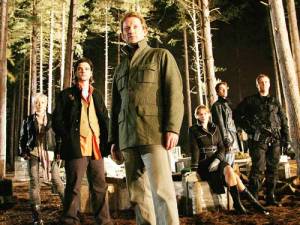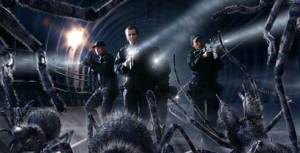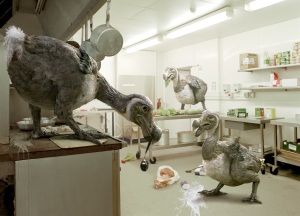ARChive 4: Directors Cilla Ware & Jamie Payne (Series 1)
Producers Cameron McAllister and Tim Haines engaged Cilla Ware and Jamie Payne to direct the first season of Primeval. In our final look back at that opening year, the two […]
Producers Cameron McAllister and Tim Haines engaged Cilla Ware and Jamie Payne to direct the first season of Primeval. In our final look back at that opening year, the two […]
 Producers Cameron McAllister and Tim Haines engaged Cilla Ware and Jamie Payne to direct the first season of Primeval. In our final look back at that opening year, the two directors explain to Paul Simpson why the show was like nothing they had worked on before…
Producers Cameron McAllister and Tim Haines engaged Cilla Ware and Jamie Payne to direct the first season of Primeval. In our final look back at that opening year, the two directors explain to Paul Simpson why the show was like nothing they had worked on before…
What were the specific challenges of Primeval?
Cilla Ware: When we cast it, none of the artists had worked with CGI before, so for them and for us, it was a baptism by fire. It took time to be able to believe that this funny little thing on a stick was actually going to be something real and alive and frightening. At first I think they did feel a bit silly and it was quite tough to make them understand, so we would use other visual references like Jurassic Park, so that they could have something to hold onto. I suspect that was the toughest challenge for all of us, because I’d be filming you, as the actor, filling the screen, and you can emote and do all of that… and then I’d turn round and there was nothing but this funny thing to shoot! For all of us it was a bit discombobulating really.
Jamie Payne: The creatures were co-leads effectively. You’re sharing the space dramatically with something you can’t see and you’ve got to trust that it’s right, so your reactions to it are true. Cilla had ploughed the way, so a lot of those early testing times Cilla went through as the piece was created: the look and the world of it.
Did you work together on that process?
Jamie Payne: Cilla was very open and not at all precious about letting me on set and sharing stuff, and being very honest. I had great benefit of that. A lot of directors aren’t like that. Cilla was very accommodating. Thank God, because it would have been very difficult, because it’s such a unique machine. There’s no model.
Cilla Ware: We were creating the model. The wonderful thing about Primeval is that each episode is really different: the creatures, the texture, the feeling. That’s what will also surprise the audience. There’s not one that feels the same. Even with our three episodes, we didn’t approach them in the same way. Each one we approached as a unique film in its own right.
We had to keep the CGI in blocks because the Framestore had to do all episode one’s CGI, then episode two, then episode three. That part was done in its respective blocks. I felt that each episode was unique to its own storyline and the creatures that were inhabiting it.
Jamie Payne: They were like different shows, and you had to become almost a different director to deal with the separate demands. Primeval has such clear intentions, but it still has the same amount of time as if it was about a family living in a house in the suburbs. You can’t just cover a scene. You’ve got to shoot the plates and then the sequence has to be covered like an action sequence. That was a huge gauntlet for both of us.
 Cilla Ware: The other thing I didn’t understand was the amount of time it takes on set. There’s a lot more discussion, because you’re not just discussing the relationships between the actors, you’re discussing their relationships with the creatures, what the creatures are doing… If you’re blocking a normal scene, everyone can see and understand each other, but when you’re blocking a CGI scene with the actors, a lot more talk goes on, and that time is ticking away when you want to be filming.
Cilla Ware: The other thing I didn’t understand was the amount of time it takes on set. There’s a lot more discussion, because you’re not just discussing the relationships between the actors, you’re discussing their relationships with the creatures, what the creatures are doing… If you’re blocking a normal scene, everyone can see and understand each other, but when you’re blocking a CGI scene with the actors, a lot more talk goes on, and that time is ticking away when you want to be filming.
Did you have the same editor for all six episodes?
Jamie Payne: It wouldn’t be possible. You can imagine the post production demands on each episode. Framestore have a very strict amount of time to turn the shots over; it’s regimented for cost reasons. It would have been impossible for one editor. It was nearly impossible for one director per block because all the shots coming back from the Framestore had to be cut in at the various stages. The editors still had to be working towards a final cut time which was the same as any other drama. They were pushed to the limits.
Cilla Ware: Tim Haines was very sure that he wanted us not to be frightened of CGI, in the sense of not going down the cheap option. “Be ambitious with your shots with CGI.” So we did use the Steadicam in a way where you were filming the actor and you would move within that to allow the creature to come into shot. That kind of choreographing with the camera works really well you when you see it, but it’s very complex. The actor is having to act with something you’re doing with the camera which then evolves into the creature coming.
Jamie Payne: It’s not like a lot of shows that use CGI: they almost lock the camera off for the CGI shots. Primeval doesn’t work like that. It’s much more fluid and much more interactive dramatically. We had to learn the rules fast.
It was interesting that Tim chose two directors whose background was primarily drama. Cilla’s done some action before, I’ve done a lot less. We come in not knowing any better. We ask for the world and then find a way of shooting it.
Did you look at other films and TV shows to emulate or consciously distance yourselves from?
Jamie Payne: Cilla, Cameron and Tim were very open about the references they used. One of the things you realise when you look at the sequences from King Kong or Jurassic Park is how many shots within that action sequence are pure CGI or animatronic. You can’t isolate the creatures and still have pace and drive. If you don’t do that, you stand still. Because I didn’t have any CGI experience, I couldn’t not look at those shows – why do those work? Why do those creatures feel natural in that environment? It’s because they’re treated like another character with their own separate coverage as opposed to the cheap option.
Cilla Ware: All the way from the beginning, we discussed that the animals had to have a character. They had to have a sense of their own identity. I think animals do anyway. There was always a debate as to how far we could go. I said we should push it. Spielberg gives the shark in Jaws a character, and you realise that people like to emotionally get involved with the character. Using a POV shot gives the character an intelligence: you have the sense that shark has its own character.
 Jamie Payne: Because audiences have such access to shows now, they don’t want to look at television and go, “We have to understand it’s the cheaper version”. It’s either going to work or not for them. From the Framestore’s point of view, that was very difficult.
Jamie Payne: Because audiences have such access to shows now, they don’t want to look at television and go, “We have to understand it’s the cheaper version”. It’s either going to work or not for them. From the Framestore’s point of view, that was very difficult.
I’ve got dodos in one of my episodes: feathers are difficult. For the Hippogriff on Harry Potter they had the time to individually animate feathers. On Primeval’s schedule they can’t do that, so they have to find a way of making them good enough but not to the point where they’re going to be rejected by the audience.
The lovely thing about Primeval though was how collaborative it was. If I didn’t have access to the understanding of how the decisions were made, it would have been difficult, but it allowed me to build on what they’d done, rather than second guess.
One of the things I think Primeval has achieved is a very clear tone. It knows what it is without apology. It’s very clear and complete in that intention. I think that only comes from that very open sharing.Adrian is a brilliant writer, and two of my episodes are written by other people who had to do the same thing I did with Cilla, fit into an already created style.
A director can’t hide anywhere on a show like Primeval. They’re director’s pieces: they’re either going to work as action because you’ve created it well, and have a balance between drama or action if you’ve put the work in. It’s a huge gauntlet to a director. You can’t hide behind anything.
Cilla Ware: The other inspiration was the original Errol Flynn movies like Captain Blood and the original Robin Hood, which had a flamboyancy and a kind of visual sense that they ended up using quite a lot in Pirates of the Caribbean. That was another kind of texture we wanted that you didn’t often see in television: it’s got a little bit more verve.
Did you work out how the dinosaur got up the stairs at the school in the first episode?
Cilla Ware: That debate went on. Everybody said we couldn’t do that but I said we could because I know that if the story is strong enough and the people are enjoying it, they don’t actually don’t care. They’ll buy into anything.
Jamie Payne: That goes back to tone: if the tone supports and celebrates that, it works. If Primeval took itself very seriously, it wouldn’t be family adventure.
Check out our other season 1 ARChives: Juliet Aubrey & Lucy Brown; Hannah Spearritt; Douglas Henshall
Don’t forget that part 2 of our exclusive interview with Adrian Hodges about the future of Primeval will be posted straight after the broadcast of episode 5 on Tuesday June 21.